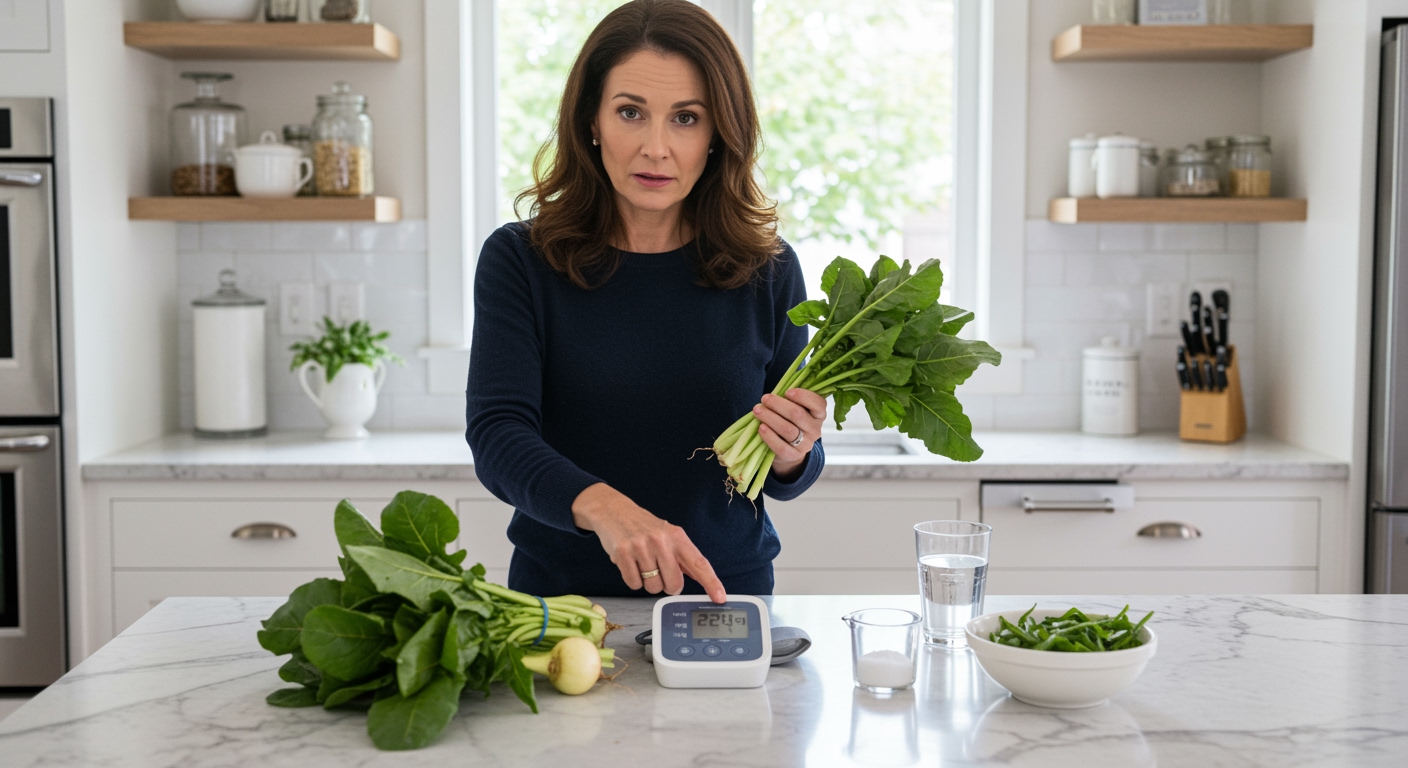✪ Key Takeaway: Turnip greens can help raise low blood pressure due to their natural sodium content and mineral profile.
Introduction
You grab a bunch of turnip greens at the grocery store thinking they will help your health goals.
But if you struggle with low blood pressure, you might wonder whether these leafy greens will make your condition worse or actually help stabilize your readings.
Hi, I am Abdur, your nutrition coach and today I am going to explain exactly how turnip greens affect low blood pressure levels and what this means for your daily meal planning.
What Makes Turnip Greens Different From Other Leafy Vegetables?
Turnip greens stand apart from spinach, kale, and other popular leafy vegetables because of their unique mineral composition.
These dark green leaves contain higher amounts of natural sodium compared to most other greens.
One cup of cooked turnip greens provides about 42 milligrams of sodium, which is significantly more than spinach or lettuce.
This sodium content works alongside potassium and magnesium to help regulate blood pressure naturally.
The calcium content in turnip greens also supports proper muscle function, including the smooth muscles in your blood vessel walls.
When your blood pressure runs too low, your body needs these minerals to help maintain proper fluid balance and vascular tone.
✪ Fact: Turnip greens contain more calcium per serving than milk, supporting both bone health and blood vessel function.
How Do These Minerals Actually Affect Your Blood Pressure?
Your blood pressure depends on the delicate balance between sodium and potassium in your bloodstream.
When you have low blood pressure, your body often needs more sodium to help retain fluid and increase blood volume.
Turnip greens provide this sodium in a natural form that your body can use effectively.
The magnesium in these greens helps your blood vessels maintain proper tone without becoming too relaxed.
This mineral also supports your adrenal glands, which produce hormones that help regulate blood pressure.
The folate content in turnip greens supports healthy red blood cell production, which can improve circulation and help stabilize blood pressure readings.
These combined effects make turnip greens particularly helpful for people whose blood pressure tends to run low.
✪ Pro Tip: Eat turnip greens with a small amount of healthy fat to improve absorption of fat-soluble vitamins.
Should You Worry About Eating Too Many Turnip Greens?
Most people with low blood pressure can safely eat turnip greens without concern about raising their blood pressure too much.
The natural sodium in these vegetables is different from processed table salt and works more gently in your system.
However, if you take medications for blood pressure or have other heart conditions, you should monitor your response carefully.
The potassium content can interact with certain medications, particularly ACE inhibitors or potassium-sparing diuretics.
People with kidney problems need to be especially careful because their bodies may not process excess potassium effectively.
For most healthy adults with low blood pressure, eating one to two cups of cooked turnip greens several times per week provides beneficial support without risk.
Always check with your healthcare provider if you notice significant changes in your blood pressure readings after adding new foods to your regular diet.
✪ Note: Keep a food and blood pressure diary to track how different foods affect your individual readings.
What Is The Best Way To Prepare Turnip Greens For Blood Pressure Support?
The way you prepare turnip greens can significantly impact their effect on your blood pressure.
Steaming or sautéing turnip greens preserves most of their mineral content while making them easier to digest.
Avoid boiling them for long periods because this cooking method leaches out water-soluble vitamins and minerals into the cooking water.
Adding a small amount of healthy fat like olive oil or avocado helps your body absorb the fat-soluble vitamins more effectively.
You can also eat turnip greens raw in salads, which preserves all their natural mineral content.
Combining turnip greens with other mineral-rich foods like nuts, seeds, or lean proteins creates a more balanced effect on blood pressure.
Avoid adding excessive salt during cooking since the greens already contain natural sodium that supports healthy blood pressure levels.
✪ Pro Tip: Massage raw turnip greens with a little lemon juice to break down tough fibers and improve digestibility.
The Bottom Line
Turnip greens can be a valuable addition to your diet if you struggle with low blood pressure because they provide natural sodium and other minerals that support healthy circulation.
The best nutrition comes from understanding how individual foods work with your unique body chemistry rather than following generic advice.
I would love to hear about your experience with turnip greens and blood pressure in the comments below, and please share any questions you might have about incorporating these nutritious greens into your meal planning.
References
At NutritionCrown, we use quality and credible sources to ensure our content is accurate and trustworthy. Below are the sources referenced in creating this article:
- Healthline: Turnip Nutrition Facts and Health Benefits
- Wholistic Matters: Turnip Greens: The Healthiest Vegetable People Aren’t Eating
- MedicineNet: Are Turnip Greens Healthy?
- Medical News Today: Turnips: Nutrition, Calories, and Benefits





